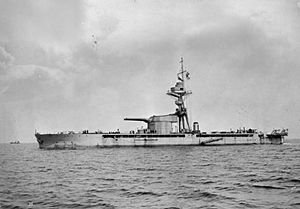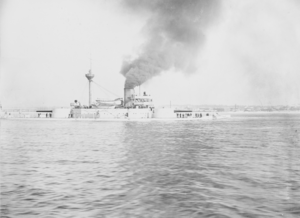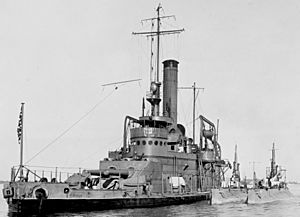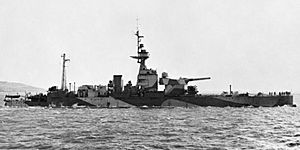Monitor (warship) facts for kids
A monitor is a special kind of warship. It is usually small and not very fast. Monitors also don't have super strong armor. But they carry really big guns for their size! Navies used them from the 1860s, during World War I and a bit in World War II.
The first monitor was designed in 1861 by John Ericsson. He named it USS Monitor. These ships were made for shallow waters, like rivers or close to coasts. They were great for defending shorelines. The word "monitor" also came to mean other ships with turrets.
In the early 1900s, the idea of monitors came back. The Royal Navy built some for bombarding shores. The Lord Clive-class monitor ships had some of the biggest guns ever on a warship! They fought German targets in World War I. These ships were later taken apart in the 1920s.
The term "monitor" also describes strong river monitors. These smaller ships were used by the United States Navy during the Vietnam War. Today, the Brazilian Navy's Parnaíba is the last monitor still in active service.
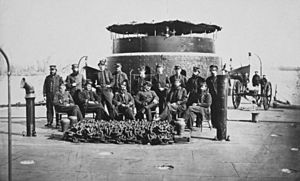
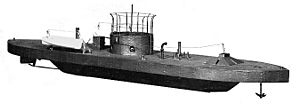
Monitors in the 1800s
American Civil War Ships
The word "monitor" comes from a Latin word meaning "someone who reminds others of their duties." This is how USS Monitor got its name. John Ericsson designed her quickly for the American Civil War (1861–65). Her job was to help the Union Navy stop supplies from reaching the Confederate States by sea. Ericsson made her for shallow water. She also had a very small target area above the water. The water itself helped protect her.
The Battle of Hampton Roads in March 1862 was famous. It was between Monitor and CSS Virginia. This was the first time two ironclad ships fought each other. Many similar battles happened during the American Civil War. Dozens of monitors were built for the United States Navy. They were designed for ship-to-ship fighting. But they also helped by attacking enemy forts from the water.
Three months after the Battle of Hampton Roads, John Ericsson took his design to Sweden. In 1865, the first Swedish monitor was built. It was named after Ericsson. Fourteen more Swedish monitors followed. One of them, Kanonbåten Sölve, served until 1922. Today, you can see her at the Maritiman marine museum in Gothenburg.
During the American Civil War, designers tried many new ideas. They built monitors with three turrets. Some had paddlewheels to move them. Others could even go partly underwater. There were also monitors armed with special spar torpedoes.
Monitors from 1866 to 1878
In the 1860s and 1870s, several countries built monitors. They used them for coastal defense. These ships were like the original Monitor. They had a low deck, no masts, and were powered by steam. They had one or two spinning, armored turrets.
Because their decks were so low, these ships were not good for sailing in the open ocean. They were always at risk of being swamped by waves. But the low deck meant they needed less armor. This made them cheaper and lighter.
Some tried to add sails to monitors. But the masts got in the way of the turrets. The weight of the masts also made the ships less stable. One ship, HMS Captain, sank in bad weather because of this design.
The War of the Pacific

A later monitor ship was Huáscar. Captain Cowper P. Coles designed her. He was a big supporter of turret ships for the Royal Navy. Huáscar was built in England for the Peruvian Navy in 1865. She was one of many monitors that also had a ram on her front.
Huáscar, led by Rear Admiral Miguel Grau Seminario, fought bravely in the War of the Pacific. She successfully attacked enemy supply lines for months. This delayed the Chilean Army's invasion of Peru. But in 1879, the Chilean Navy captured her at the Naval Battle of Angamos.
After being captured, Huáscar fought a small battle with the Peruvian monitor Manco Capac. This happened during the bombardment of Arica. Huáscar was damaged, and Manco Capac was sunk by her own crew to prevent capture.
Today, both Chile and Peru respect the ship and the brave officers who fought on her. Huáscar is now a museum ship in Talcahuano. She has been restored to look almost like she did originally. You can visit her!
Monitors from 1884 to 1897
To make monitors better for sea travel and shore attacks, a new type appeared. These were called breastwork monitors. They had raised turrets and a heavier structure above the hull. They were still not great for long ocean trips. This was because they couldn't travel far and their steam engines often broke down.
The first of these ships was HMVS Cerberus. She was built between 1868 and 1870. Later, she was sunk to create a breakwater near Melbourne, Australia. You can still see her upper parts sticking out of the water today.
Monitors in the Spanish–American War
Monitors were used a lot during the Spanish–American War in 1898. Some important United States Navy monitors were USS Amphitrite, USS Puritan, USS Monterey, and USS Terror. These ships fought in battles like the Bombardment of San Juan and the Battle of Fajardo. They also took part in the Philippines Campaign.
Some older Civil War monitors were also brought back into service. They were used for coastal defense. This was to calm fears about surprise Spanish attacks. But these old ships were too slow and outdated to be very useful in a real fight.
Monitors in the 1900s
Monitors in World War I
During World War I, the Royal Navy built several new types of ships. They were designed to help soldiers fighting on land. These were also called "monitors." They were not much like the old 19th-century monitors. But they shared some features: they were not good in rough seas, had a shallow bottom, and carried heavy guns in turrets.
The first group, the Humber class class, was originally planned as large river gunboats for Brazil. Later monitors were built quickly and cheaply. They often used spare guns from ships that were scrapped or never finished. They were very wide for stability, which made them extremely slow. They were not good for naval battles or open ocean travel. Royal Navy monitors helped protect the left side of the Western Front in 1914.
Many monitors were built during the war. Their main guns often came from old battleships that were no longer in use. These monitors were also made to resist torpedo attacks. They had special bulges on their sides to protect them. As the war went on, these heavier monitors patrolled the Strait of Dover. They stopped enemy ships from entering the English Channel. HMS General Wolfe, a Lord Clive-class monitor, got an 18-inch gun in 1918. She could shell a bridge 20 miles away near Ostend! Other British monitors served in the Mediterranean Sea.
Monitors came in many different sizes. The Abercrombie class was 320 feet long and 90 feet wide. They drew 9 feet of water. The smaller M29-class monitors were only 170 feet long. The Erebus class class from 1916 was 405 feet long. The biggest monitors carried the heaviest guns.
By this time, the United States Navy had mostly stopped using monitors. Only a few were left, and seven were still in service. They were used as submarine tenders, helping submarines. This was the last war where U.S. monitors were actively used. The last original American monitor, USS Wyoming, was removed from the Navy List in 1937.
The Austro-Hungarian Navy also built many river monitors. They patrolled rivers like the Danube. These ships were among the first to fire on Serbia at the start of World War I. They also took part in the bombardment of Belgrade. After the war, the remaining ships were given to the navies of Yugoslavia and Romania. Some of them even fought in World War II.
The Italian Navy also built some monitors. One was the Faa di Bruno. It used big gun barrels from battleships that were never finished.
Monitors in World War II
Most of the smaller Royal Navy monitors were scrapped after World War I. But Erebus and Terror survived to fight in World War II. When shore support was needed again, two new large Roberts-class monitors were built. These were Roberts and Abercrombie. They were fitted with 15-inch guns from older battleships.
Royal Navy monitors helped the British Eighth Army in the desert and Italian campaigns. They also helped bombard the shore during the Invasion of Normandy in 1944. They cleared the German-mined River Scheldt so the British could use the port of Antwerp. Roberts and Abercrombie were also planned to help free Singapore in late 1945. But this plan was canceled when Japan surrendered.
The old Italian WWI monitor Faa di Bruno was used as a floating battery in WW2. She was captured by the Germans and used as the monitor Biber. She was scrapped after the war.
German, Yugoslav, Croatian, and Romanian navies all used river monitors on the Danube River. They saw many battles during the war.
Soviet River Monitors
The Soviets built many monitors before World War II. They mostly used them on rivers and lakes. After their experiences in WWI and the Russian Civil War, the Soviets designed new monitors for their river fleets. The first ship of this new type was Zheleznyakov. It was built in Kiev in 1934. Today, Zheleznyakov is a museum ship on the Dnieper River.
Monitors from 1946 to 1964
The Royal Navy still had HMS Abercrombie (finished 1943) and HMS Roberts (finished 1941) in reserve in 1953. They were typical monitors. They were about 373 feet long and 90 feet wide. They drew about 11 feet of water and carried two 15-inch guns.
The Brazilian Navy still uses the last true "monitor" today. It is the Parnaíba. She is part of their inland waterway force.
Monitors in the Vietnam War
The Vietnam War was the U.S. Navy's second river war. The first was the American Civil War. In 1965, the U.S. Navy decided to bring back a "brown-water navy" for South Vietnam. This meant a navy for rivers and shallow coastal areas. Plans were made in 1966, and the U.S. Navy formed a Mobile Riverine Force (MRF).
Before 1966, U.S. Navy boats like Swift Boats and PBRs were fighting in Vietnam. But they weren't winning much in the Mekong Delta. A stronger naval force was needed. It had to be heavily armored and have powerful guns.
The U.S. Navy's MRF included "River Assault Flotilla One." This group had four "River Assault Divisions." Each division had several monitors. These "river battleships," as the sailors called them, worked with other boats.
Vietnam monitors were made from old World War II Landing Craft Mechanized (LCM) Mark 6s. These were 56-foot-long steel boats. Ten monitors were armed with a 40 mm cannon. Later, some monitors got 105 mm howitzers or flamethrowers. The flamethrowers were mounted in special turrets on the sides. Because there weren't enough 105 mm howitzers, only 8 of these "Monitor (H)" versions were made.
The 24 U.S. Navy monitors in Vietnam had about 10 tons of armor. They were about 60 feet long and 17.5 feet wide. They had two engines and could go up to 8.5 knots (about 10 miles per hour). They usually had a crew of 11. When South Vietnam fell in 1975, all these monitors were captured. Only one training monitor, C-18, stayed in the U.S. You can see it at the Naval Amphibious Base Coronado in Coronado, California.
Similar Vessels
River Monitors
Monitors showed how good turrets were compared to fixed guns. This helped lead to the development of the dreadnought battleship. Because monitors had a shallow bottom, they also led to river gunboats. These were used by powerful countries to patrol their colonies. The biggest and most heavily armed river gunboats became known as river monitors. Navies from the United Kingdom, the United States, and Japan used them.
Submarine Gunboats
USS Monitor had a very low deck. This was to keep the heavy gun turret low, which made the ship more stable. It also made it a smaller target for enemy fire. At the end of the American Civil War, the U.S. Navy's Casco-class monitors had large ballast tanks. These tanks let the ships go partly underwater during battle.
The Royal Navy took this idea further with their R-class submarine gunboats. The British M-class submarines were first designed to bombard shores. But their purpose changed to attacking enemy merchant ships. Their 12-inch gun was better at long range than a torpedo against a moving target. Only one, HMS M1, was ready before World War I ended. She sank in the English Channel in 1925 after being accidentally hit while underwater. Her gun broke free, and she flooded completely.

Surviving Vessels
- The Russian Strelets is an Uragan-class monitor built in 1864. She was still floating in St. Petersburg, Russia, in 2015. People are trying to restore her.
- The Peruvian Huáscar is a monitor built in England in 1865. She is still floating in her original condition in Talcahuano, Chile.
- HMVS Cerberus, launched in 1868, was sunk as a breakwater off Australia in 1926. Work is being done to preserve her.
- HNLMS Schorpioen (1868) and HNLMS Buffel (1868) are Dutch ramming ship monitors. They are now museum ships.
- SMS Leitha (now "Lajta Monitor Múzeumhajó") is an Austro-Hungarian monitor built in 1871. She is currently a museum ship.
- HSwMS Sölve is a Swedish monitor built in 1875. She was designed by John Ericsson, the "father" of all monitors. She is now in a Maritime Museum in Gothenburg, Sweden.
- SMS Bodrog is an Austro-Hungarian monitor built in 1904. She is said to have fired the first shots of World War I. She is now a museum ship in Belgrade, Serbia.
- HMS M33 is an M29-class monitor of the Royal Navy built in 1915. She is preserved at Portsmouth Historic Dockyard in the United Kingdom.
- Parnaíba is a river monitor still used by the Brazilian navy today.
See also
 In Spanish: Monitor (barco) para niños
In Spanish: Monitor (barco) para niños


